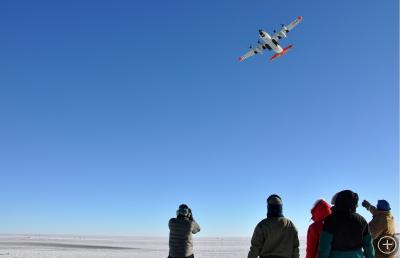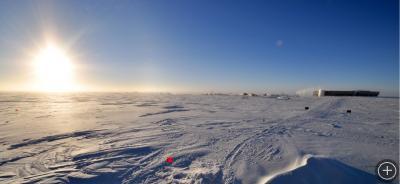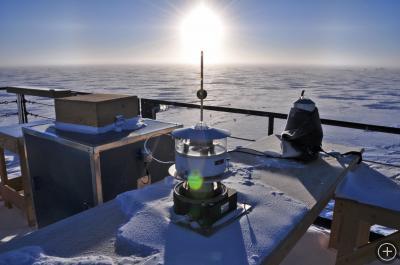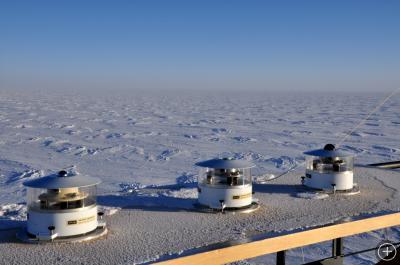As Sunset Approaches…Let’s Talk Solar Radiation
SOUTH POLE, ANTARCTICA– Station closing occurred on February 14th at 2:30 AM as the last flight did a spectacular fly-by to wish us well on our eight month deep freeze. No more cargo in or out and we are on our own now. Despite it being 2:30 in the morning, witnessing that last flight gets the adrenaline pumping and most of us are wide awake. We held a little subdued celebration in the galley enjoying the fact that the pace is going to slow down here immensely. This is what we’ve been waiting for and it’s now here. It’s time to settle in and get into our winter routines.
We have just barely over two weeks until the sun sets and temperatures are already starting to drop quickly. The day of station closing, temperatures were around -40F. Today it is the coldest since I’ve been here at -63F, and tomorrow it’s suppose to bottom out at almost -70F. It’s amazing how quickly it drops when that sun gets low. The cold temperatures also make everyday things difficult to deal with. We had an emergency response drill today that took place outside and I volunteer on the fire team. You have to be really conscious about your gear because the SCBA (Self Contained Breathing Apparatus) hoses start to freeze and can crack easily. A fire fighter isn’t much good without a working SCBA. Frostbite is a big concern as well. The fire gear gloves and boots are not insulated for cold and do a very poor job of keeping your fingers and toes warm.
As for the science here at ARO (Atmospheric Research Observatory), not too much has changed. I’m still coming out here every day to check to make sure everything us running as it should be and taking air samples in flasks every week. One thing that is starting to change is our ability to do Dobson observations. The Dobson Spectrophotometer is an instrument that uses sunlight to measure total column ozone in the atmosphere. When the sun is this low on the horizon, there is a lot of stray refracted light that affects the measurements and can give us bad results. You may ask, “How do you take measurements in the winter?” Well this is done by using the reflected sunlight off of the moon. So we are able to take sporadic observations to coincide with our balloon flights through the winter. The solar radiation instruments on the roof will be coming down soon after sunset as well, which will be a small project for us. Here is a brief description of the solar radiation measurements we have at ARO and why we are measuring it.
Incoming solar radiation is the backbone of what drives our climate. Changes in the amount of radiation reaching the earth from the sun can be the difference between being in an ice age or not. It is important for us to know how much radiation is a) reaching the surface, b) what type of radiation it is (wavelength), and c) how much is bouncing back off the surface. This is what’s called the “Radiation Budget” in its most basic form. The “Radiation Budget” involves many other processes but the pictures and descriptions below show how we break down the “Radiation Budget” into its basic components at ARO.
The NIP tracks the sun in all 360 degrees. It measures direct incoming solar radiation of specific wavelengths.
The diffuse pyranometer blocks out the incoming direct solar radiation and measures any radiation that is getting reflected and refracted from substances in the atmosphere (or any radiation taking an indirect path to the surface).
These pyranometers detect all incoming solar radiation both direct and indirect. The two outer ones have filters on them to divide it up into shortwave (UV) and longwave (infrared) radiation.
The “Albedo Rack” is basically exactly the same as the pyranometers except that they are turned upside down. They then measure the amount of solar radiation that is reflected off of the earth’s surface. Roughness and color play a role in Albedo meaning that a smooth surface is going to reflect more than a rough surface, and a white surface is going to reflect more than a black surface.. Therefore, it is important not to disturb the snow under these instruments because we want the natural state of the surface. In addition to reflected radiation, it monitors infrared radiation emitted by the earth.

A more complex version of the “Radiation Budget” or “Energy Balance” pulled from the IPCC Fourth Assessment Report.
As you can see, in the above figure, there is a lot that really goes into the “Radiation Budget” and it is a very complex system. When the solar energy comes into the atmosphere, it can take a variety of paths. It can get interrupted by clouds, gases, aerosols and other substances. Two of these processes in the system we observe at ARO as well such as Aerosols, and Greenhouse Gases which I will talk about in a later post.
Hopefully this explains a little bit what’s behind the solar radiation observations that we take at ARO. The South Pole and Mauna Loa have the longest continuous running solar radiation observations of this kind. It’s extremely important that we understand what happens to solar radiation as it passes through the atmosphere and hits the earth’s surface if we want to gain a good understanding of how earth’s climate works. It is even more important as we try to predict future climates.

















Thank you for this! We have been collecting shadow lengths here in Albuquerque and other places in the world for 3 years to demonstrate angle of isolation and are just this year we are using thermochrons to compare the ambient air temperature to solar angle. Although this is a group of middle school students, they will find your post helpful in understanding why we study the sun. If you were to measure the shadow of the sun from a 1-meter stick, how long would you expect it to be at this point so close to sunset?
Hi Turtle,
Well it’s been cloudy and pretty disturbed weather lately. But the elevation sun angle is at 4.9 degrees right now above the horizon. But, if you do the math by using the angle of the sun and length of the stick, it should equal 1/Tan(4.9). So about 11 or 12 feet?
Perfect! I’ll share with the kids and we’ll walk it out for comparison. Our length at 35.05 N is running 82 cm as we approach equinox and our angle using an antique brass astrolabe is 55-degrees. We are working with tools of historical mariners to compare them to current as well as measuring the sun. Al helped us with this project for the past two years but we haven’t had a reading of the length/angle so close to equinox before. A new question came up after Chile’s quake. Students are wondering as to how much, if it will be measurable that is, will the angle change as a result of the minor shifting? Any thoughts?
Our project page is under Sun Shadow Data at the ANDRILL Project Circle website: http://web.me.com/lhuffman/Project_Circle/Welcome_.html
Well I’m not really sure how far reaching the quake in Chile was. I don’t have anything to base it on but I imagine if it did have any effect it would be extremely minimal. By just looking at the solar data that we have, I don’t think we could distinguish a change on that scale. That being said, maybe they would be able to see something after the data is processed and analyzed back at the ESRL in Boulder.
Thanks for sharing this. I think pyranometers are a good solution against solar radiation. Hope they aren’t too expensive and can be used by ordinary people, too.
This is some great information!
This important as any changes in the amount of radiation reaching the earthcan be the difference between being in an ice age or not.